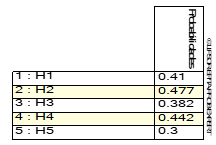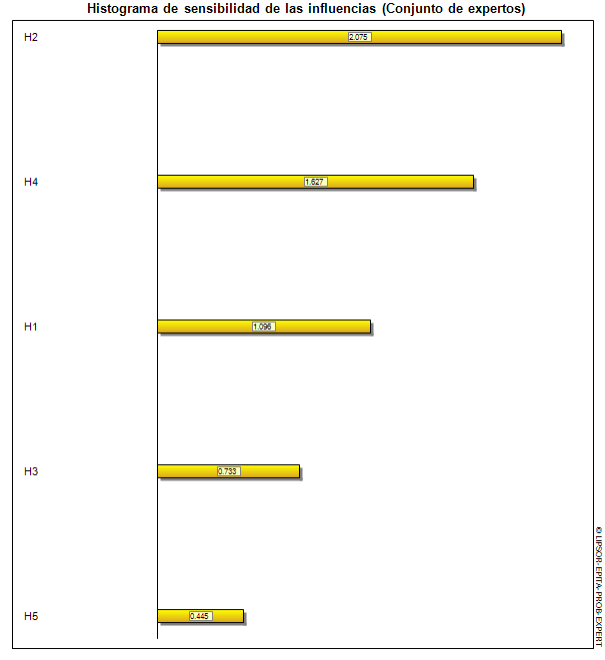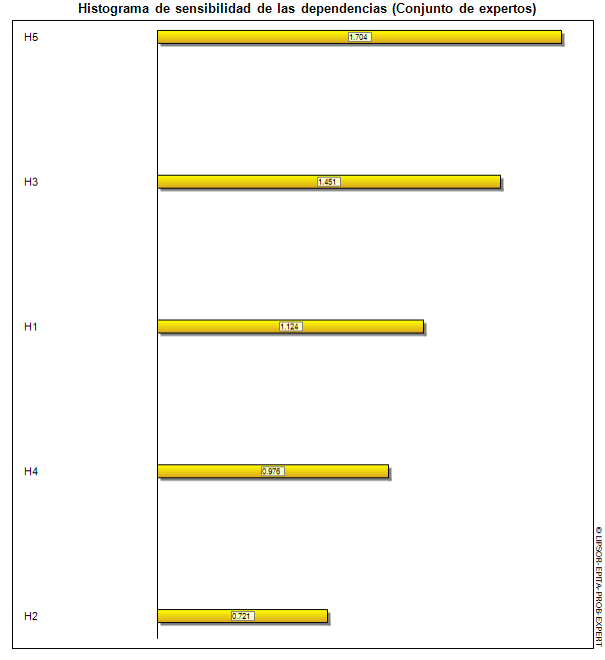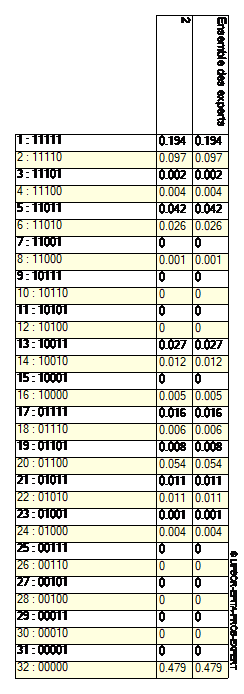
Mendive. Journal on Education, july-september 2022; 20(3): 809-820
Translated from the original in Spanish
Original article
Problem-Based Learning: most likely scenario of application in the Ecuadorian high school
El Aprendizaje Basado en Problemas: escenario más probable de aplicación en el bachillerato ecuatoriano
Aprendizagem baseada em problemas: cenário mais provável de aplicação no ensino médio equatoriano
Gustavo Bernardo Tipán
Cañaveral1![]() http://orcid.org/0000-0002-7218-4684
http://orcid.org/0000-0002-7218-4684
Daniel Fernando Tipán
Cañaveral2![]() http://orcid.org/0000-0003-4895-1676
http://orcid.org/0000-0003-4895-1676
Alejandro Rubén Zapata
Cañaveral3![]() http://orcid.org/0000-0002-4177-7102
http://orcid.org/0000-0002-4177-7102
David Fernando Arroyo Nazareno1![]() http://orcid.org/0000-0003-3402-2040
http://orcid.org/0000-0003-3402-2040
1Mejía National Institute. Ecuador. ![]() gustavo.tipan@educacion.gob.ec
gustavo.tipan@educacion.gob.ec
2Central University of Ecuador ![]() ddtipan49@gmail.com
ddtipan49@gmail.com
3Educative Fiscal Unit of Pichincha. Ecuador ![]() alejandro.zapata@educacion.gob.ec
alejandro.zapata@educacion.gob.ec
Received: March 18th, 2022.
Accepted: April 26th, 2022.
ABSTRACT
Problem-based learning is one of the teaching approaches that in recent decades has made it possible to advance in the improvement of educational processes, by promoting a greater role for students, interaction with the environment through knowledge and solutions to specific situations. In the work, an analysis was carried out to define the most probable scenario on the application of this method at the high school level in Ecuador. For this, theoretical analysis methods were applied based on updated bibliography and the consultation of seven experts in secondary education in Ecuador for the development of a prospective qualitative analysis method, which allowed defining the most probable scenario. The study carried out demonstrated the importance of applying the method in high school, considering the particular characteristics of teenagers, their level of intellectual and psychological development; as well as the social relationships established with their peers, teachers, family and the environment in general; however, with the application of the scenario analysis based on the criteria of the participating specialists and processing with the SMIC-ProbExpert software, it was determined as well as identified that it is most likely that none of the future hypotheses for its implementation will be met. in the country generally. For this purpose, the importance of teacher preparation and institutional support was ratified.
Keywords: adolescents; learning; problem-based learning; high school; scenario; teaching approaches; teaching methods.
RESUMEN
El Aprendizaje Basado en Problemas es uno de los enfoques de enseñanza que en las últimas décadas ha permitido avanzar en el mejoramiento de los procesos educativos, al promover un mayor protagonismo de los estudiantes, la interacción con el medio a través del conocimiento y solución a situaciones específicas. En el trabajo se realizó un análisis para definir el escenario más probable sobre la aplicación de este método en el nivel de enseñanza media en Ecuador. Para ello se aplicaron métodos de análisis teórico con base a bibliografía actualizada y la consulta a siete expertos en educación media de Ecuador para el desarrollo de un método de análisis cualitativo prospectivo, el cual permitió definir el escenario más probable. El estudio realizado demostró la importancia de la aplicación del método en el bachillerato, considerando las características particulares de los adolescentes en esa edad, su nivel de desarrollo intelectual y psicológico, así como las relaciones sociales que se establecen con sus compañeros, docentes, familia y medio en general; sin embargo, con la aplicación del análisis de escenarios con base al criterio de los especialistas participantes y procesamiento con el software SMIC-ProbExpert se determinó que lo más probable es que no se cumpla ninguna de las hipótesis de futuro para su implementación en el país de forma generalizada. Para dicho propósito, se ratificó la importancia de la preparación de los docentes y el apoyo institucional.
Palabras clave: adolescentes; aprendizaje; aprendizaje basado en problemas; bachillerato; escenario; enfoques de enseñanza; métodos de enseñanza.
RESUMO
A Aprendizagem Baseada em Problemas é uma das abordagens de ensino que nas últimas décadas tem possibilitado avançar na melhoria dos processos educativos, promovendo maior protagonismo dos alunos, interação com o meio através do conhecimento e soluções para situações específicas. No trabalho, foi realizada uma análise para definir o cenário mais provável para a aplicação deste método no ensino médio no Equador. Para isso, foram aplicados métodos de análise teórica com base em bibliografia atualizada e a consulta de sete especialistas em educação secundária no Equador para o desenvolvimento de um método de análise qualitativa prospectiva, que permitiu definir o cenário mais provável. O estudo realizado demonstrou a importância da aplicação do método no ensino médio, considerando as características particulares dos adolescentes nessa idade, seu nível de desenvolvimento intelectual e psicológico, bem como as relações sociais estabelecidas com seus pares, professores, família e meio em que vivem. em geral; no entanto, com a aplicação da análise de cenários com base nos critérios dos especialistas participantes e processamento com o software SMIC-ProbExpert, determinou-se que é muito provável que nenhuma das hipóteses futuras seja cumprida para sua implementação no país de forma generalizada. Para tanto, ratificou-se a importância da preparação docente e do apoio institucional.
Palavras-chave: adolescentes; Aprendendo; Aprendizagem baseada em problemas; ensino médio; cenário; abordagens de ensino; métodos de ensino.
INTRODUCTION
The implementation of active methodologies and the use of materials to achieve a dynamic that distances itself from traditional teaching, in addition to promoting higher educational quality, allow the formation of critical, reflective and competent students. The purpose of applying current teaching methods is to achieve autonomous and quality learning that, according to Sáez (2018, p. 9) " is achieved by confronting situations in which students have to apply new knowledge to make decisions and solve problems from a reflective perspective", which should lead to what is recognized as significant learning, associated with a comprehensive understanding of the context of what has been learned and its usefulness.
As is known, numerous elements converge in the complex process of teaching and learning, in which learning strategies and styles stand out, understood as the decisions made and the techniques applied by learners in their process (strategies); and, on the other hand, the innate cognitive, physiological and affective characteristics that they have for it (styles). Based on Sáez (2018) , there are various techniques that can be applied to enhance the use of learning strategies and styles, such as exposure, brainstorming, problem-based learning, role-playing, discussion forums, etc. discussion, the project method and the case method.
In the present investigation, the Problem-Based Learning (PBL) method is addressed, which is characterized by group work to analyze, synthesize and solve problems that have their origin in real life, favoring interaction between students and with the environment, and stimulating socialization and pragmatism in the face of new experiences, according to the styles proposed by Kolb (1985) as part of his experiential learning approach. For practical purposes, in this paper the terms method, methodology, approach, technique will be used interchangeably to refer to PBL.
The main characteristics of PBL, which place it as a non-traditional and innovative method for the educational contexts of recent decades, are: the role of the student in learning to learn, the facilitator role of the teacher, leading to active learning, constructive and integrated, its ability to enhance multidisciplinary skills and competencies adjusted to the environment in which the student operates, among others (Luy, 2019).
One of the most interesting edges that authors such as Morales (2018) give to PBL is its influence on improving the research capabilities of teachers and students, provided that the method is used properly and directed to sharing research experiences in which the student each once again acquires independence and autonomy in the process, considering that the analysis of problem situations can influence the active development of thought.
In general, PBL is recognized for its quality of developing cognitive and constructivist teaching-learning processes, through the use of real problems that promote individual and self-regulated learning and in group mode through collaborative learning, where the the teacher's role is basically that of a facilitator, for which education and training programs consistent with these new methods are required.
The bibliographic search carried out with an exploratory nature, prior to the development of the research, allowed us to identify that most of the current publications on PBL focus on its application in Higher Education, due in large part to the fact that " its learning environment is conducive to the development of higher order thinking skills, such as critical thinking " (Morales, 2018 , p. 91) .
Therefore, it is interesting to delve into its usefulness and applicability in other levels of education, such as high school; which has very specific characteristics, especially due to the age group of adolescents, their association mechanisms, interests, level of motivation and other psychological factors. In the opinion of Torralbas & Escandón (2022) , despite the fact that at this age the most common is the formation of groups, these do not always have a positive impact on learning outcomes, since their relationships are based on " hierarchical structures, little connected and with low quality of links especially in the exercise of the task " (p. 105).
The widespread application of more innovative methods in high school would allow laying solid foundations for higher education, considering that in general at this level the behavioral approach still predominates with examinations, presentations and other traditional techniques, which limits a rapid familiarization with the methods that are generally used in Higher Education, of a systemic and constructivist nature (Samaniego, et al., 2019) . Therefore, the utility of the PBL application, like other similar methods, has a double function; on the one hand, the improvement of the results of teaching various subjects in high school and, on the other, the integral formation of the student, creating competencies for his future performance, with emphasis on the human, affective and social components.
In the curricular programs of the high school in Ecuador, one of the expected results is precisely to achieve a high problem-solving capacity on the part of the students, despite the fact that the method is not standardized at this level of education, nor are many documented studies on its implementation. In this sense, this research aims to identify the most likely scenario of the applicability of problem-based learning at the middle school or high school level in Ecuador, based on the theoretical foundations and the criteria of experts in the field.
MATERIALS AND METHODS
In the first instance, a documentary bibliographical research was developed, focused on identifying the foundations and results of the application of the Problem-Based Learning method, specifically at the high school level. For this, current and quality bibliographic sources were consulted, extracted from databases such as Scielo, Redalyc, Dialnet, Google books and others.
The analysis carried out was based on the application of research methods such as systemic, analytical and hypothetical deductive, in order to expose the key ideas in the different topics addressed and which are developed below.
Additionally, the SMIC prospective qualitative method (Godet, 2000) was applied , which allows defining the most probable scenario(s) on a particular topic, based on the identification and prioritization of future hypotheses. Seven specialists in secondary education from Ecuador participated in the study, who obtained a score between 0.95 and 0.98 on a scale of 1, based on the expert evaluation method adapted by Cabero & Barroso (2013) ; demonstrating a high level to participate in the expert consultation carried out.
RESULTS
The application of the SMIC method was based on the definition and validation by the experts of the following hypotheses for the future, based on the theoretical analysis carried out previously.
Table 1- Future hypothesis
Hypothesis |
Definition |
H1 |
PBL is recognized as an innovative method, useful for the meaningful learning of high school students. |
H2 |
Teachers have the required preparation to implement PBL. |
H3 |
Information and communications technologies are used to support the implementation of PBL. |
H4 |
There is institutional support for the implementation of PBL in schools. |
H5 |
Students and families are motivated by the application of innovative methods such as PBL. |
After that, the following matrices for determining the probabilities of simple and conditional occurrence of the hypotheses were applied electronically, as an input for processing with the SMIC-ProbExpert software (LIPSOR, 2010) , which is part of a package of mathematical-statistical analysis programs to develop scenarios in the framework of strategic planning exercises.

Fig. 1- Probability matrix of simple occurrence of the hypotheses
Source: Own elaboration based on Godet's methodology (2000)

Fig. 2- Probability matrix of conditional occurrence of the hypotheses
Source: Own elaboration based on Godet (2000)
The scale for the completion of the matrices by the experts was as follows:
Table 2- Hypothesis evaluation scale.
Characteristic |
probability value |
almost impossible event |
0.1 |
unlikely event |
0.3 |
moderately likely event |
0.5 |
probable event |
0.7 |
almost certain event |
0.9 |
Independent events |
Empty |
Source: Own elaboration based on Godet (2000)
As evidenced, the value of the probability on the scale grows as it is evaluated that the event is more likely to occur.
Figure 3 shows the result of the calculation of the simple probabilities of the five hypotheses considered in the study, based on the criteria of experts.

Fig. 3- Probability of occurrence of the hypotheses
Source: SMIC-ProbExpert software outputs
As noted, the probabilities of occurrence of the five hypotheses are in the range of 0.3 to 0.5, qualifying from low to medium, being the hypothesis related to the preparation of teachers the one that specialists grant the highest probability of occurrence ( P=0.477), and the motivation on the part of students and relatives the lowest (P=0.3).
To expand the analysis of the hypotheses studied, the sensitivity histograms of the influences and the dependencies between them are shown below, noting that the most influential hypothesis is H2 and the most dependent is H5.


Fig. 4- Histograms of sensitivity of influences and dependencies of the hypotheses
Source: SMIC-ProbExpert software outputs
The following figure shows the calculation of the probability of occurrence of the 32 possible scenarios, which are formed from the combination of the five hypotheses.

Fig. 5- Probability of occurrence of the hypotheses
Source: SMIC-ProbExpert software outputs
According to the previous results, the most probable scenario in relation to the studied topic is 32, in which none of the five hypotheses is fulfilled, with a probability value of 0.479. This indicates that, in general, the experts visualize that the future conditions do not yet exist for the generalized implementation of the PBL method in the Ecuadorian high school.
DISCUSSION
Although PBL has been developing for decades, it continues to be seen as an innovative approach, since it allows the teaching process to go from an instructional phase to a constructive one; that the student is an active subject in his learning, which in turn acquires an eminently social character, being in accordance with the most accepted pedagogical trends, especially constructivism. All this allows us to recognize that PBL is one of the most useful tools to achieve meaningful learning in the context of student-teacher-school-environment relationships , as part of the education models that should be promoted in the countries to favor " development of all the capacities for the realization of the personal life project and as a means to transform reality " (Luy, 2019 , p. 354) .
However, according to the criteria of the specialists consulted, the probability is low-medium that PBL will be recognized as an innovative method in the Ecuadorian high school, which is a reflection that even the curricular programs do not reflect the aspiration of connection with the social environment, problem solving and meaningful learning of adolescents (Zambrano, Bravo, Zambrano & Basurto, 2020).
The second hypothesis of the future considered in the study was related to the preparation of teachers, being the most driving (influential) of the five and with the highest probability of occurrence. In this sense, it is recognized that the role of the teacher, more than an instructor, is that of a tutor or mentor, directing students to learn and cooperate with the required quality, renouncing being the only transmitter of knowledge. Likewise, the teacher must have the specific knowledge and skills to handle PBL, which is much broader than the use of a problem in the context of the class; managing to interact in a productive and sensitive way with students, creating a space of well-being and motivation for all.
The deficiencies of teachers in the use of innovative teaching methods and strategies is one of the main limitations in the successful development of the educational process, which must be solved with comprehensive solutions that come from the study programs of pedagogical careers, and the actions aimed at their improvement and training, by the organizations of the education sector and the educational institutions themselves.
In recent years, the incorporation of Information and Communication Technologies (ICT) to education has spread; specifically in the implementation of the PBL, these tools are also beginning to be used, with a positive impact on the improvement of the intellectual activity of the students through greater stimuli, promotion of initiative, handling of errors and collaborative work. These technologies also optimize time and quality in the search for information to solve problems, and the execution of associated investigative processes. This was the third hypothesis considered in the research, denoting that the conditions to promote the use of PBL through ICTs do not yet exist, as it appears to be one of the least influential and most dependent hypotheses.
This can be considered as a loss of opportunity, if one takes into account that at high school age there is greater interest in the management of technological means, social networks and others that, well directed, favorably affect the success of the educational teaching process.
Success in the use of PBL is evidenced by numerous scientific scholars, and the authors associate it with higher levels of academic performance, autonomy, self-regulation, critical thinking, collaborative work, emotional intelligence, motivation, among other skills acquired by students (Luy, 2019).
Based on all its benefits, the ABP should have the support and promotion of the institutions of the educational system, from the levels of government to the schools themselves; however, in Ecuador there are still problems with the curriculum and school organization that affect the academic performance and acquisition of skills of the students (Ramírez, 2020).
In the research, hypothesis four was recognized for its high influence over the rest, as a sign of the importance, according to the criteria of the specialists consulted, of institutional support for the widespread implementation of this type of novel approach, especially in high school, also considering that the age range in high school studies is generally between 16 and 18 years old, in which adolescent traits predominate, which are recognized for their high complexity (Tagliaferro, 2016) , due to the multiple biological, psychological and emotional changes that occur, also causing changes in the personal, family and social relationships of adolescents. The challenges of education at this stage of life are considerable, which is why, as Ponce (2020) expresses , comprehensive solutions are required from the State and educational institutions to meet the demands of adolescents in crisis.
In this order of ideas, it coincides with Valles & Covarrubias (2020) , who state that it is necessary to study and delve into the characteristics of the PBL methodology at different educational levels, contexts and subjects; This will allow its fundamentals, advantages and disadvantages to be expanded and documented, becoming a source of consultation for teachers in improving their teaching skills and for institutions in its implementation.
Despite the fact that, as indicated before, the greatest application of PBL occurs in higher education, it is considered very important that, from lower levels, specifically the baccalaureate, this type of teaching approach is applied, due to the possibility of that foundations are laid so that the student is aware of their own learning process and their emotional, intellectual and personal development. All this will allow an organized transition to university and professional life in the future (Valles & Covarrubias, 2020) .
Based on Samaniego and others (2019) , teaching methods, the educational environment and the capacities of teachers are key to the success of the educational teaching process in secondary education, and in hypothesis five the level of motivation. of the students and support of the families for the success in the implementation of the PBL and resulting with the lowest level of probability of occurrence and motor skills was considered. The importance of studying this hypothesis for the future is framed in the fact that the boundaries between school, classroom and environment are increasingly blurred, for which family communication, relationships with peers, the school and community environment are key, for which these should become factors to consider in educational processes at these specific ages.
This should be one of the fundamental lines of action to be considered by the institutions of the educational system, in order to guarantee the support required by families and other actors in the school environment, influencing student motivation.
Undoubtedly, there is evidence about the successful application of PBL in the context of high school, especially focusing on academic results, motivation, self-regulation, autonomy, improvement in skills and socialization skills, among others. As has been highlighted, the introduction of PBL has innumerable benefits for the student, but without a doubt in secondary education it has limitations, especially because interdisciplinary work is required, which at this level does not predominate, evidenced by low learning results and student performance in many cases (Valles & Covarrubias, 2020) and affectations in the cognitive, emotional and social order (Sevilla, Martín & Ramírez de Arellano (2020) ; the school is, together with other actors such as the family, community and society in general, in the obligation to overcome, thus ensuring that education is directed towards the creation of better citizens and societies.
The benefits of applying PBL are increased in contexts of greater economic and social vulnerability for high school students, since it better connects the student and the teacher with the solution of environmental problems that are , in general, more complex due to the characteristics of the environment (Ponce, 2017) . Hence the importance of knowing the factors that limit its implementation, such as the hypotheses considered in this study that are combined in a probable scenario of non-performance, under the criteria of the participating specialists.
The work carried out made it possible to recognize that educational processes today must be increasingly connected with social demands, which must be taken into account by the institutions of the educational system and the educational institutions themselves; for this there are theories and pedagogical approaches consistent with such purposes, especially constructivism.
In the work, the specific case of Problem-Based Learning was addressed, which, although it has been applied for years, is widely accepted due to its influence on the improvement of intellectual and psychological capacities in students, as well as in the generation of better relationships with students, their peers, teachers and external environment.
The application of Problem-Based Learning was deepened at the middle school or high school level, where there it is not much evidence of its use, but it is recognized that it is very interesting and important, considering the particular characteristics of adolescents at this stage of life development., together with other educational and social factors that were addressed in the work; especially its ability to prepare students for higher education and life beyond.
The SMIC prospective qualitative analysis method was applied, with the participation of seven specialists from secondary education in Ecuador, determining that the conditions for the widespread implementation of PBL in high school are not yet visualized, especially due to the low probability of occurrence of the five hypotheses studied. Among them, the high influence of the preparation of teachers and institutional support for such purposes stands out; as well as the high dependence on student motivation and family support, on the rest of the hypotheses considered.
BIBLIOGRAPHIC REFERENCES
Cabero Almenara, J., & Barroso Osuna, J. M. (2013). La utilización del juicio de experto para la evaluación de TIC: El Coeficiente de competencia experta. Bordón. Revista de Pedagogía, 65(2), 25-38.
Godet, M. (2000). La caja de herramientas de la prospectiva estratégica. Editorial Gerpa. http://es.laprospective.fr/dyn/espagnol/bo-lips-esp.pdf
Kolb, D. A. (1985). Learning Style Inventory: Self Scoring Test and Interpretation Booklet. Mcber and Company. https://www.scirp.org/(S(351jmbntvnsjt1aadkposzje))/reference/ReferencesPapers.aspx?ReferenceID=1690677
Luy Montejo, C. (2019). El Aprendizaje Basado en Problemas (ABP) en el desarrollo de la inteligencia emocional de estudiantes universitarios. Propósitos y Representaciones, 7(2), 353-383. https://doi.org/10.20511/pyr2019.v7n2.288
Morales Bueno, P. (2018). Aprendizaje basado en problemas (ABP) y habilidades de pensamiento crítico ¿una relación vinculante? Revista Electrónica Interuniversitaria de Formación del Profesorado, 21(2), 91-108.
Ponce Grima, V. M. (2017). Adolescencias mexicanas en riesgo: Retos para su educación. Temas de Educación, 23(2), 292-309.
Ponce Grima, V. M. (2020). Adolescencias mexicanas en riesgo: Retos para su educación. Temas de Educación, 23(7). https://acervodigitaleducativo.mx/handle/acervodigitaledu/53418
Sáez López, J. M. (2018). Estilos de aprendizaje y métodos de enseñanza. Universidad Nacional de Educación a Distancia UNED. https://dialnet.unirioja.es/servlet/libro?codigo=713383
Sevilla Santo, D. E., Martín Pavón, M. J., Ramírez de Arellano De la Peña, J. A., & Sunza Chan, S. P. (2020). Barreras personales para el aprendizaje en estudiantes de bachillerato. Contextos Educativos. Revista de Educación, 26, 197-217. https://doi.org/10.18172/con.4227
Tagliaferro, G. (2016). La adolescencia y sus dinámicas: Comprender, educar y gestionar la edad de los grandes cambios. EDE (Ediciones Dehonianas España). https://www.amazon.com/-/es/Giovanni-Tagliaferro/dp/8416803021
Torralbas Oslé, J. E., & Escandón Cabrera, R. (2022). Análisis de la cohesión grupal en escuelas de enseñanza media-superior especializada en La Habana. Universidad de La Habana, 288, Article 288. http://www.revuh.uh.cu/index.php/UH/article/view/212
Valles Ramírez, A. X., & Covarrubias Papahiu, P. (2020). Metodología ABP: Habilidades de autonomía y trabajo colaborativo en estudiantes de bachillerato. Paradigma, 2, 286-310.
Zambrano-Mendoza, J. R., Bravo-Vélez, M. G., Zambrano-Mendoza, H. J., & Basurto-Vélez, M. A. (2020). Diseño curricular como factor determinante para mejorar la calidad educativa en educación secundaria del Ecuador. Dominio de las Ciencias, 6(2), 261-275. https://doi.org/10.23857/dc.v6i3.1217
Conflict of interest:
Authors declare not to have any conflicts of interest.
Authors´ Contribution:
The authors have participated in the writing of the work and analysis of the documents.
![]()
This work is under a licencia de Creative Commons Reconocimiento-NoComercial 4.0 Internacional
Copyright (c) Gustavo Bernardo Tipán
Cañaveral, Daniel Fernando Tipán
Cañaveral, Alejandro Rubén Zapata
Cañaveral, David Fernando Arroyo Nazareno